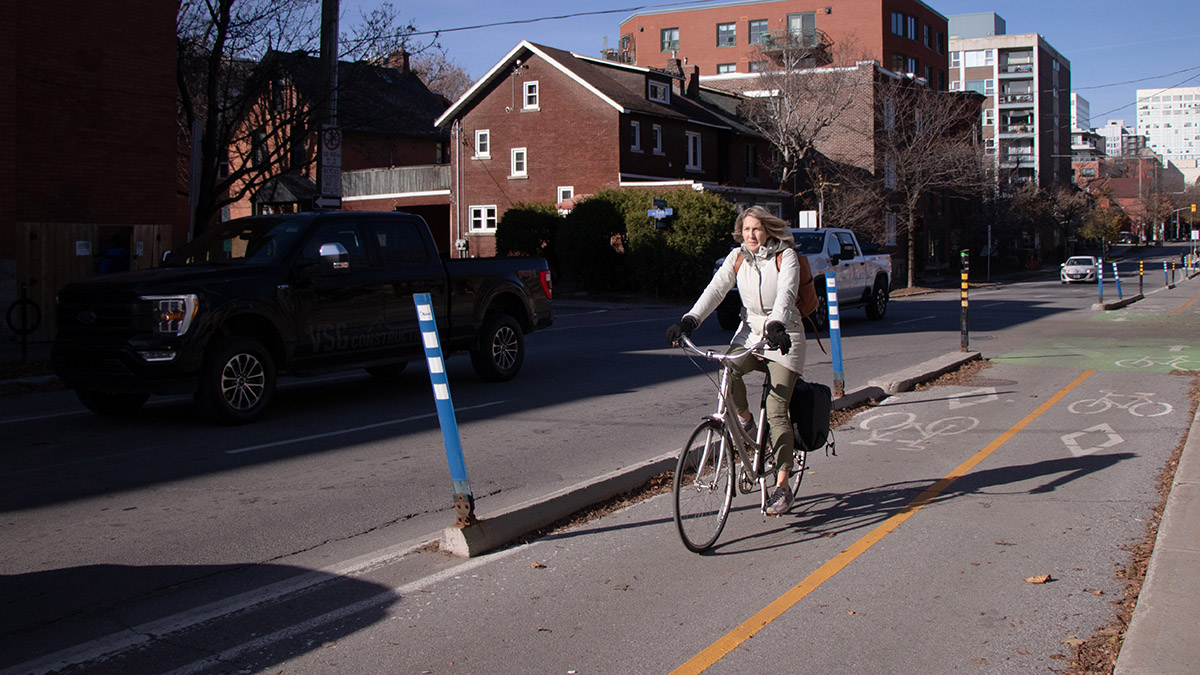Without bike lanes in Ottawa’s cycling network, José Albornoz wouldn’t have felt comfortable taking his first few rides around town six years ago, after moving from Chile.
Albornoz, who started the Ottawa by Bike website to help locals navigate the city’s cycling network, worries that Ontario’s Bill 212 will hinder his mission to get more Ottawa residents on two wheels.
The province’s Reducing Gridlock, Saving You Time Act, which received royal assent Nov. 25, requires municipalities to approve future bike lane projects with the Ministry of Transportation. Bill 212 also grants ministerial power to reconsider existing bike lanes with the goal of alleviating motor vehicle congestion.
The legislation “aims to put an end to the chaos of bike lanes once and for all,” Transportation Minister Prabmeet Sarkaria said at Queen’s Park on Nov. 25, citing “some of the worst travel times in North America” for motor vehicles.
“We’re going to work with Ontarians and relieve the congestion,” he said. “Our government will get traffic moving again by building priority projects, such as Highway 413, the Bradford Bypass and making sure we remove these silly bike lanes on the busiest corridors in our province.”
But in cities such as Ottawa, where municipal data finds nearly 100,000 trips are now made daily by bike, cyclists fear losing protective road infrastructure and having to compete more with cars for room on the road.
“By adding friction into new bike lanes and removing the existing ones, we cripple the network,” Albornoz said.

Ottawa has some 22 kilometres of segregated bike lanes, with each part of the network receiving cyclists anywhere from a few hundred to several thousand times per day.
Until Nov. 20, the provincial government had invited public feedback to hear comments on Bill 212. Albornoz was among those who submitted their sentiments.
“More bike lanes translates into less cars on the road,” he said. “In general, everyone’s average commute should go down when you take into account the people that can now go to work [by] bike.”
Joel Harden, NDP member of provincial parliament for Ottawa Centre, agrees.
“I believe in reducing congestion,” he said. “Car drivers know that the more cyclists there are, the fewer cars are on the road [to compete with].”
Harden, an avid cyclist, has been vocal at Queen’s Park against Ford’s legislation.
Other parties have also mobilized to oppose Bill 212, including on Oct. 26 when groups such as Bike Ottawa and Ecology Ottawa organized a protest cycle that toured from Confederation Park to Bayview Yards. Ecology Ottawa struck a petition calling for city council to demand Bill 212 be withdrawn, and 13 councillors signed a separate open letter to Ford.
William van Geest, Ecology Ottawa’s executive director, points out that Ottawa’s official plan wants most people getting around by transit, carpooling, walking and cycling by 2046 — a plan the provincial government has approved.
“When congestion has already reached a crisis point, when drivers are at their wits’ end, removing traffic lanes to build bike lanes doesn’t make sense,” Sarkaria argued. “It only makes gridlock worse.
Yet the concept of induced demand, studied across Western society, finds that building or widening roads can merely attract more motor vehicles instead of decreasing congestion. Narrow bottlenecks in roadways, above all else, drive congestion throughout motor vehicle networks, according to research.
While roads regularly are congested by cars, bike lanes keep thousands of cyclists moving, van Geest said.
“Biking is way more efficient,” he said. “Some people still think that if you add car lanes, that will ease congestion. We’ve known for decades that the opposite is true.”
Legislation targets specific bike lanes
Though Ford’s government has mainly named bike lanes in the Greater Toronto Area, Ottawa cyclists are fretting about ones in Centretown disappearing because of Bill 212.
“We have active transportation lanes, bike lanes in process right now that would be impacted,” Harden said.
He noted that Sarkaria mentioned removing the O’Connor Street bike lane upon tabling the legislation. Cyclists pass through that bike lane an estimated 150,000 times per year, according to the councillors’ open letter.
“There is no way that someone in Toronto at Queen’s Park or the Ministry of Transportation knows what are the actual needs of people in Ottawa that are getting about on their bikes,” said Guillaume Gaillard, who sits on the board for Bike Ottawa.
Gaillard fears for the improvement project planned next year for Albert and Slater streets. It would add larger bike lanes by narrowing roadways and removing parking, but Gaillard and other cyclists have “raised a red flag” to city council that Bill 212 will jeopardize the project.
“In my reading of the legislation, that would require Queen’s Park’s approval before moving ahead,” Harden said, despite council having already approved it.
Sarkaria said during his statement at Queen’s Park Ontario’s government will “establish a clear set of criteria for reviewing municipalities’ requests to ensure we’re taking a fair and consistent approach” to considering a proposed bike lane’s impact on traffic volume, emergency response times and road safety. Municipalities will be asked to share data on local bike lane projects started in the last five years.
“If we determine that building those bike lanes would make congestion worse, they will not get built,” Sarkaria said. “Our government fully supports bike lanes that reduce congestion and keep traffic flowing through cities, but these lanes need to be on secondary roads.”
Losing the bike lanes on Ottawa’s Laurier and O’Connor streets, van Geest said, would fragment his regular safe cycling routes. Albornoz expects Bill 212 will crush hopes for a more prominent bike lane on Bank Street.
“I feel like that’s now definitely going to be out of the question,” Albornoz said, adding he also worries about losing the Wellington Street bike lane for his own leisurely cycling.
Continuing to promote safety
In 2023, some 49,100 collisions involving motorists resulted in serious injury or death, according to Ministry of Transportation figures. There were nearly 1,800 cyclists injured, and 16 killed.
For Ottawa, the most recent data available shows that about 9,600 collisions happened in 2022.
Harden hopes continuing to build Ottawa’s bike lane network can reduce these numbers.
“Everyone wins when we have a transportation system that’s based on ensuring road safety and ensuring efficiency of access,” Harden said, inviting cyclists to share their own road safety stories.
Gaillard noted that cyclists have different comfort levels when sharing the road with cars, making bike lanes critical.
Preserving Ottawa’s bike network also “adds safety for all road users and not just people on bikes,” he said, and makes drivers more conscious of cyclists around them.
“You have safety in numbers,” Gaillard explained, saying drivers often lack awareness of bikes. “Once you raise a critical mass of people, then all of a sudden, they cannot ignore you. You become very much part of their surroundings that they pay attention to.”
Gaillard, who’s cycled for 20 years, says losing bike lanes in Ottawa won’t stop him.
“I’m just going to be in the car lane, taking the lane to be safe,” Gaillard said. “It will be more dangerous for me and it will be more annoying for motorists. Nobody will gain.”
For van Geest, bike lanes remain a “game-changer” in an urbanized society.
“In North America, we’ve destroyed much of our walkable and bikeable world in favour of car infrastructure, and that just makes it dangerous for everyone,” he said.
Despite Ottawa’s bike lanes in jeopardy with Bill 212, the cycling community will continue promoting safe practices for sharing open road with cars.
“The province should let the city take care of its own traffic planning,” said David Palmer, president of the Ottawa Bicycle Club, which has about 1,000 members. “What might work for the GTA may not be appropriate for Ottawa.”
This club, for instance, actively trains cyclists to ride safely on busy roads. Palmer said new members are required to take a two- or three-hour road safety expedition, with options available for child cyclists. Pedalheads also runs a summer program teaching road bike safety to children ages two to 12 in cities including Ottawa.
“I appreciate there are a lot of cyclists that don’t have that comfort riding in traffic,” Palmer said. “Bike lanes are probably even more important to them — just that extra feeling of safety.”




